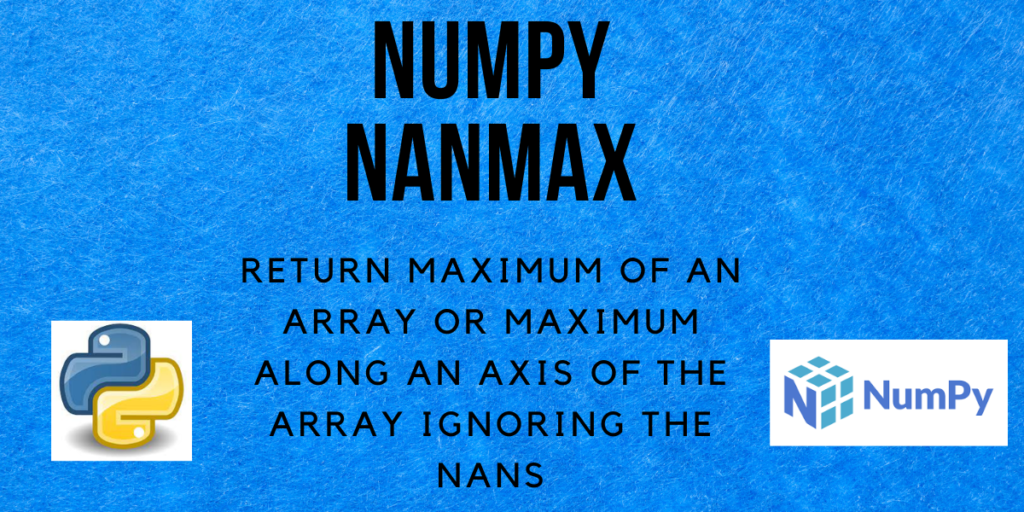Hello and welcome to this tutorial on Numpy nanmax. In this tutorial, we will be learning about the NumPy nanmax() method and also seeing a lot of examples regarding the same. So let us begin!
Also read: NumPy amax – Maximum of an array of maximum along an axis
What is NumPy nanmax?
In Python, NaN denotes Not a Number. If we have an array that contains some NaN values and want to find the maximum value in it, we can use the nanmax() method from NumPy.
The nanmax() method in NumPy is a function that returns the maximum of the array elements calculated by ignoring the NaN values in the array. It can be the maximum of all the array elements, the maximum of the array elements along the rows, or the maximum of the array elements along the columns.
We will see the examples for each of these in the upcoming section of this tutorial.
Syntax of NumPy nanmax
Let us have a look at the syntax of the nanmax() function.
numpy.nanmax(a, axis=None, out=None, keepdims=<no value>, initial=<no value>, where=<no value>)
| Parameter | Description | Required/Optional |
| a (array_like) | Input data. | Required |
| axis | Axis along which the maximum of the array is to be calculated. It can be axis=0 or axis=1 or axis=None which implies that the maximum of the entire array is to be returned. | Optional |
| out | An alternative output array in which to place the result. It must have the same shape as the expected output. | Optional |
| keepdims (bool) | If this is set to True, the axes which are reduced are left in the result as dimensions with size one. With this option, the result will broadcast correctly against the input array. | Optional |
| initial | The minimum value of an output element. | Optional |
| where | Elements to compare for finding the maximum. | Optional |
Returns:
An array containing the maximum of the array along the specified axis, ignoring all the NaNs.
Examples of NumPy nanmax
Let’s get right into the different examples of using numpy.nanmax() function.
Nanmax of a 1-d array
import numpy as np
arr = [5, 32, 10, np.nan, 4]
# using the nanmax function to calculate the maximum
ans = np.nanmax(arr)
print("arr =", arr)
print("Result =", ans)
Output:
arr = [5, 32, 10, nan, 4]
Result = 32.0
Ignoring the NaN value, the maximum value among 5, 32, 10 and 4 is 32, hence it is returned.
Nanmax of a 2-d array
import numpy as np
arr = [[-12, 3], [np.nan, 36]]
# using the nanmax function to calculate the maximum
ans = np.nanmax(arr)
print("arr =", arr)
print("Result =", ans)
Output:
arr = [[-12, 3], [nan, 36]]
Result = 36.0
Similar to the previous example, the maximum of -12, 3, and 36 is 36.
Nanmax along an axis of the array
axis = 0
import numpy as np
arr = [[5, 8], [np.nan, 36]]
# using the nanmax function to calculate the maximum
ans = np.nanmax(arr, axis=0)
print("arr =", arr)
print("Result =", ans)
Output:
arr = [[5, 8], [nan, 36]]
Result = [ 5. 36.]
Here, the values in each row for a specific column are compared to find the maximum element.
ans[0] = max(arr[0][0], arr[1][0]) = max(5, np.nan) = 5 (ignoring NaN)
ans[1] = max(arr[0][1], arr[1][1]) = max(8, 36) = 36
axis = 1
import numpy as np
arr = [[5, 8], [np.nan, 36]]
# using the nanmax function to calculate the maximum
ans = np.nanmax(arr, axis=1)
print("arr =", arr)
print("Result =", ans)
Output:
arr = [[5, 8], [nan, 36]]
Result = [ 8. 36.]
When axis=1, the elements in each row are compared over all the columns to find the maximum.
ans[0] = max(arr[0][0], arr[0][1]) = max(5, 8) = 8
ans[1] = max(arr[1][0], arr[1][1]) = max(np.nan, 36) = 36 (ignoring NaN)
NumPy nanmax of an array containing infinity
Let us now see how the numpy.nanmax() method handles infinity along with NaNs in the array.
import numpy as np
# array containing +infinity
a = np.array([25, np.nan, 36, np.inf, 8])
# array containing -infinity
b = np.array([25, np.nan, 36, np.NINF, 8])
# array containing +infinity and -infinity
c = np.array([25, np.nan, 36, np.inf, np.NINF, 8])
max_a = np.nanmax(a)
max_b = np.nanmax(b)
max_c = np.nanmax(c)
print("a =", a)
print("Maximum of the array a =", max_a)
print("\nb =", b)
print("Maximum of the array b =", max_b)
print("\nc =", c)
print("Maximum of the array c =", max_c)
Output:
a = [25. nan 36. inf 8.]
Maximum of the array a = inf
b = [ 25. nan 36. -inf 8.]
Maximum of the array b = 36.0
c = [ 25. nan 36. inf -inf 8.]
Maximum of the array c = inf
In the above code, NINF denotes -infinity and inf denotes infinity. Note that,
- If the array contains positive infinity then the maximum is positive infinity.
- If the array contains negative infinity then the maximum is the maximum of all the elements, ignoring the NaNs.
- If the array contains both positive and negative infinity, then the maximum of the array is inf, i.e. positive infinity.
Summary
That’s all! In this tutorial, we learned about the Numpy nanmax method and practiced different types of examples using the same.
If you want to learn more about NumPy, feel free to go through our NumPy tutorials.
